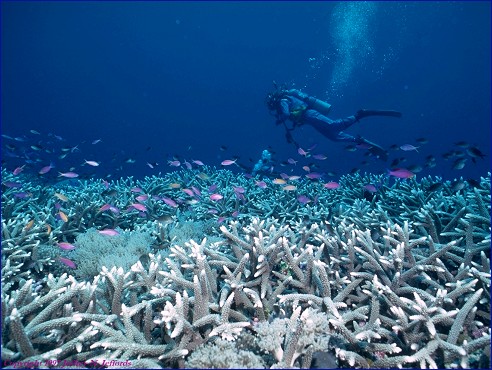|
| This is a good view of a healthy reef-- lots of hard corals providing shelter for
thousands of reef creatures. The coral shown is a type of hard coral; in fact, what you
see here is actually the skeleton of the coral. The coral creatures are soft-bodied and
are retracted inside the coral skeletons, typically emerging during hours of darkness. This type of coral is fast-growing, as much as an inch or more a year. Often typhoons will generate wave action that breaks the branches of entire colonies of such corals in shallow water such as this (about 15 feet). Over a period of many months or sometimes years, the colony recovers to its original delicate form. Coral colonies require clear, nutrient-free, sunlit water to thrive. Many varieties are hermatypic, possessing algae in their branches that process sunlight into food for the coral colony. If the water is polluted, the sunlight is blocked, preventing the algae from providing nutrition for the coral. If the water has excess nutrients, algae suspended in the water near the surface blooms excessively, in turn blocking the sunlight from reaching the reef corals. When a coral colony dies, the entire ecosystem of the reef is affected, since most of the reef creatures depend on the coral structures for shelter. Coral colonies (and their reefs) are damaged by humans in various ways. Probably foremost is damage from soil and pesticide runoff from land. In many countries, such as the Philippines, deforestation causes soil to pollute the rivers through increased erosion. The river runs into the ocean, polluting the nearby reefs. Another mechanism of reef destruction is chemical pollution, seen in the North American Keys, in which pesticides and fertilizer from soil runoff pollute nearby reefs. Certain types of fishing methods also prove harmful to the reef. Lastly, divers and boats may damage reefs through accidents, dropping and dragging of anchors, or diver clumsiness. Identification: Acropora sp. (genus Acropora, species unidentifiable without closer examination) |

